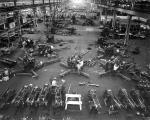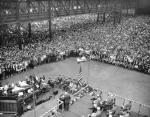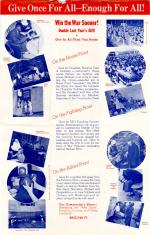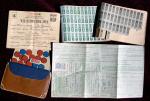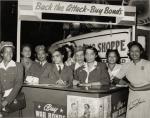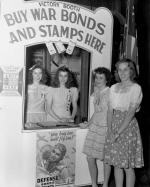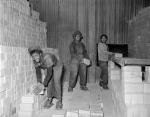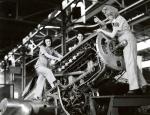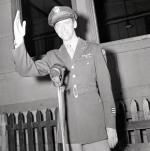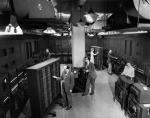Chapter 3: The Pennsylvania Homefront
As the United States was gearing up its industrial might to prepare the nation for war, Pennsylvania Governor  Arthur James, paraphrasing one of president Franklin Delano Roosevelt's better-known quips, proudly boasted that the Keystone State would become the "Arsenal of America." And indeed, the Commonwealth's industries helped ensure Allied victory in World War II. Pennsylvania's key geographical position–the "Keystone State" nickname was aptly earned during the Revolutionary War–ensured that the important role that the state would play in the nation's war effort.
Arthur James, paraphrasing one of president Franklin Delano Roosevelt's better-known quips, proudly boasted that the Keystone State would become the "Arsenal of America." And indeed, the Commonwealth's industries helped ensure Allied victory in World War II. Pennsylvania's key geographical position–the "Keystone State" nickname was aptly earned during the Revolutionary War–ensured that the important role that the state would play in the nation's war effort.
Pennsylvania's industrial potential, which had begun to emerge from the throes of the Depression as a result of government financing of war-related industries, helped place the state in the forefront of the nation's burgeoning military-industrial might. Pennsylvania was a major producer of both anthracite and bituminous coal. Pittsburgh's legendary steel industry was supplemented by the vast holdings of Bethlehem Steel, led by Eugene Grace.
Eugene Grace.
During the course of World War II, Pennsylvania supplied 31 percent of America's steel and 20 percent of worldwide production, a phenomenal accomplishment. The state was also the country's leading supplier of Portland cement. Though the state's oil production had declined–it had led the nation into the early 1900s–Pennsylvania produced the nation's highest quality of vital lubricating oil and its refineries churned out millions of gallons of 100-octane gasoline, a necessity for modern aircraft engines. Agricultural production also rose, as farmers pitched in to help the war effort.
The totality of the war effort needed to fight a global conflict affected every Pennsylvanian. The federal government rationed meat, sugar, gasoline, rubber tires, coffee, and other vital products, and the war effort drastically cut into items most consumers could previously buy.The war cost lots of money–billions and billions of dollars–that the federal government asked the people to help fund by purchasing government bonds that would mature ten years after the date of issue.
could previously buy.The war cost lots of money–billions and billions of dollars–that the federal government asked the people to help fund by purchasing government bonds that would mature ten years after the date of issue.
After the first war bond drive started on May 1, 1941, the government saturated the country with bond sales advertising and enlisted hundreds of celebrities to help convince Americans to buy bonds. From then until the end of the last drive on January 3, 1946, the American people bought $185.7 billion in government bonds. The federal government raised 46 percent of its money for the war effort with taxes; the remaining 54 percent came through borrowing, and most of that through the bond sales.
The war also had a profound impact on race relations in the Commonwealth and the nation. Early in 1942, the Pittsburgh Courier launched its Double V Campaign, urging African Americans to fight for "Victory at Home, Victory Abroad." Prominent black Pennsylvanians, including NAACP field secretary and Courier vice president Daisy Lampkin led war bond campaigns and impressed upon their communities the importance of helping America win the war, and by doing so furthering the cause of civil rights. Black Pennsylvanians responded by joining the armed forces, which were still segregated, buying war bonds, and working in record numbers in defense industries, where segregation was prohibited by presidential order.
Daisy Lampkin led war bond campaigns and impressed upon their communities the importance of helping America win the war, and by doing so furthering the cause of civil rights. Black Pennsylvanians responded by joining the armed forces, which were still segregated, buying war bonds, and working in record numbers in defense industries, where segregation was prohibited by presidential order.
The Commonwealth also mobilized its resources and citizens for the war effort. In 1943, Harold James was succeeded as the governor of Pennsylvania by General Edward Martin, the former commander of the
Edward Martin, the former commander of the  28th Division. "Right now nothing matters but winning the war," Martin said in his inaugural speech, "because if we do not win it, nothing else will matter." To win the war, the legislature gave Martin the power to suspend or modify any law that impeded the war effort, subject to review by a six-man legislative panel.
28th Division. "Right now nothing matters but winning the war," Martin said in his inaugural speech, "because if we do not win it, nothing else will matter." To win the war, the legislature gave Martin the power to suspend or modify any law that impeded the war effort, subject to review by a six-man legislative panel.
The war touched every facet of society. More than 1.6 million Pennsylvanians served in the state's volunteer army of civil-defense workers, acting as airplane spotters, caring for equipment, administering the state rationing system, and performing other vital services. At the peak in December 1943, more than 2.5 million Pennsylvanians worked in industries.
With more than 900,000 Pennsylvania men and some 22,000 women serving in the armed forces, the Commonwealth had a desperate need for workers. More than a million women entered the work force during the war, performing jobs previously reserved for men only. Taking part in a great national wartime migration, southern blacks poured into Pittsburgh, Philadelphia, Chester, and other cities to work in the factories and shipyards.
The American entertainment industry also mobilized to support the war effort. Many of the country's biggest stars went into the military, including Pennsylvania's own Jimmy Stewart, who piloted B-17s in the air war over Germany. Other stars, including bandleader
Jimmy Stewart, who piloted B-17s in the air war over Germany. Other stars, including bandleader  Les Brown used their talents to entertain the troops. Decimated by the loss of players who were drafted or volunteered for service, Baseball managers sought out the best talent they could find, including one-armed outfielder
Les Brown used their talents to entertain the troops. Decimated by the loss of players who were drafted or volunteered for service, Baseball managers sought out the best talent they could find, including one-armed outfielder  Pete Wyshner, from Nanticoke, PA.
Pete Wyshner, from Nanticoke, PA.
The beefed up American military was a pervading presence across the state. Soldiers could be seen everywhere. Millions of soldiers crossed the state on Pennsylvania's railroads, and received food and a warm welcome at the Connellsville Canteen and other community-sponsored canteens. Pennsylvania was home to more than forty military bases, ranging from the venerable Philadelphia Navy Yard and Carlisle Barracks to hastily-constructed sites such as
Connellsville Canteen and other community-sponsored canteens. Pennsylvania was home to more than forty military bases, ranging from the venerable Philadelphia Navy Yard and Carlisle Barracks to hastily-constructed sites such as  Camp Reynolds. Eight colleges joined the Navy's V-12 officer training program while others set up programs for the Army. Existing bases were enlarged to handle the influx of soldiers and supplies. Even the Pennsylvania Turnpike was pressed into service, as a vital military artery.
Camp Reynolds. Eight colleges joined the Navy's V-12 officer training program while others set up programs for the Army. Existing bases were enlarged to handle the influx of soldiers and supplies. Even the Pennsylvania Turnpike was pressed into service, as a vital military artery.
The state's industrial output was staggering. Existing factories retooled to make a variety of weapons, vehicles, aircraft, and parts. The state's contribution to the war effort ranged from battleships and tanks to torpedoes, bombs, and rations. The Sun Shipbuilding Company in Chester constructed 281 T-2 tanker oil carriers, nearly 40 percent of all the tankers built during the war. The American Bantam Car Co. in Butler PA designed and produced the first
Sun Shipbuilding Company in Chester constructed 281 T-2 tanker oil carriers, nearly 40 percent of all the tankers built during the war. The American Bantam Car Co. in Butler PA designed and produced the first  jeeps.
jeeps.
Led by steel, industries in Pittsburgh produced a broad range of material for the war effort. The Dravo Corporation built the new class of attack landing craft that made possible the successful Allied invasions in Italy, Normandy, and all the major island campaigns in the Pacific. The
Dravo Corporation built the new class of attack landing craft that made possible the successful Allied invasions in Italy, Normandy, and all the major island campaigns in the Pacific. The  Pittsburgh Grease Plant manufactured the waterproof grease vital for successful amphibious operations in France and the Pacific. Aircraft motors, rayon for parachutes, armor plate for warships, reconnaissance aircraft, compasses, radio crystals-Pennsylvania industry supplied it all.
Pittsburgh Grease Plant manufactured the waterproof grease vital for successful amphibious operations in France and the Pacific. Aircraft motors, rayon for parachutes, armor plate for warships, reconnaissance aircraft, compasses, radio crystals-Pennsylvania industry supplied it all.
To help house the influx of workers looking to find jobs in the defense industries, the federal government helped finance and build new housing projects in major cities. Mooncrest, Allegheny County, still survives as a Pittsburgh suburb. Women also left their homes in large numbers to work in factories alongside men. By 1945, more than one-third of the entire work force was composed of women. Rosie the Riveter became a national icon, while WASP pilot
Mooncrest, Allegheny County, still survives as a Pittsburgh suburb. Women also left their homes in large numbers to work in factories alongside men. By 1945, more than one-third of the entire work force was composed of women. Rosie the Riveter became a national icon, while WASP pilot  Helen Richey and other women garnered headlines by serving in all branches of the armed forces.
Helen Richey and other women garnered headlines by serving in all branches of the armed forces.
World War II was fought in laboratories as well as in factories and on battlefields. During the war, Pennsylvania was a center of technological innovations. Philadelphia's Philco Corporation created the Plexiglas canopies for American aircraft. Engineers at the University of Pennsylvania designed ENIAC, the world's first digital computer. In nearby West Chester,
ENIAC, the world's first digital computer. In nearby West Chester,  G. Raymond Rettew developed a method for the mass production of penicillin that saved millions of lives.
G. Raymond Rettew developed a method for the mass production of penicillin that saved millions of lives.
Technologies and expertise developed during the war also laid the groundwork for future innovations. Specializing in the quality fabricator of precision aircraft parts during the war, the Lavelle Company of Newtown, Pennsylvania, would become one of the nation's most trusted aerospace contactors and participate in the construction of the nation's First Weather Satellite. After the war the Johnsville plant of the Brewster Aeronautical Corporation would evolve into the
First Weather Satellite. After the war the Johnsville plant of the Brewster Aeronautical Corporation would evolve into the Johnsville Naval Air Development Center, which conducted critical work for NASA and the American space program.
Johnsville Naval Air Development Center, which conducted critical work for NASA and the American space program.
Pennsylvania's industrial potential, which had begun to emerge from the throes of the Depression as a result of government financing of war-related industries, helped place the state in the forefront of the nation's burgeoning military-industrial might. Pennsylvania was a major producer of both anthracite and bituminous coal. Pittsburgh's legendary steel industry was supplemented by the vast holdings of Bethlehem Steel, led by
During the course of World War II, Pennsylvania supplied 31 percent of America's steel and 20 percent of worldwide production, a phenomenal accomplishment. The state was also the country's leading supplier of Portland cement. Though the state's oil production had declined–it had led the nation into the early 1900s–Pennsylvania produced the nation's highest quality of vital lubricating oil and its refineries churned out millions of gallons of 100-octane gasoline, a necessity for modern aircraft engines. Agricultural production also rose, as farmers pitched in to help the war effort.
The totality of the war effort needed to fight a global conflict affected every Pennsylvanian. The federal government rationed meat, sugar, gasoline, rubber tires, coffee, and other vital products, and the war effort drastically cut into items most consumers
After the first war bond drive started on May 1, 1941, the government saturated the country with bond sales advertising and enlisted hundreds of celebrities to help convince Americans to buy bonds. From then until the end of the last drive on January 3, 1946, the American people bought $185.7 billion in government bonds. The federal government raised 46 percent of its money for the war effort with taxes; the remaining 54 percent came through borrowing, and most of that through the bond sales.
The war also had a profound impact on race relations in the Commonwealth and the nation. Early in 1942, the Pittsburgh Courier launched its Double V Campaign, urging African Americans to fight for "Victory at Home, Victory Abroad." Prominent black Pennsylvanians, including NAACP field secretary and Courier vice president
The Commonwealth also mobilized its resources and citizens for the war effort. In 1943, Harold James was succeeded as the governor of Pennsylvania by General
The war touched every facet of society. More than 1.6 million Pennsylvanians served in the state's volunteer army of civil-defense workers, acting as airplane spotters, caring for equipment, administering the state rationing system, and performing other vital services. At the peak in December 1943, more than 2.5 million Pennsylvanians worked in industries.
With more than 900,000 Pennsylvania men and some 22,000 women serving in the armed forces, the Commonwealth had a desperate need for workers. More than a million women entered the work force during the war, performing jobs previously reserved for men only. Taking part in a great national wartime migration, southern blacks poured into Pittsburgh, Philadelphia, Chester, and other cities to work in the factories and shipyards.
The American entertainment industry also mobilized to support the war effort. Many of the country's biggest stars went into the military, including Pennsylvania's own
The beefed up American military was a pervading presence across the state. Soldiers could be seen everywhere. Millions of soldiers crossed the state on Pennsylvania's railroads, and received food and a warm welcome at the
The state's industrial output was staggering. Existing factories retooled to make a variety of weapons, vehicles, aircraft, and parts. The state's contribution to the war effort ranged from battleships and tanks to torpedoes, bombs, and rations. The
Led by steel, industries in Pittsburgh produced a broad range of material for the war effort. The
To help house the influx of workers looking to find jobs in the defense industries, the federal government helped finance and build new housing projects in major cities.
World War II was fought in laboratories as well as in factories and on battlefields. During the war, Pennsylvania was a center of technological innovations. Philadelphia's Philco Corporation created the Plexiglas canopies for American aircraft. Engineers at the University of Pennsylvania designed
Technologies and expertise developed during the war also laid the groundwork for future innovations. Specializing in the quality fabricator of precision aircraft parts during the war, the Lavelle Company of Newtown, Pennsylvania, would become one of the nation's most trusted aerospace contactors and participate in the construction of the nation's









